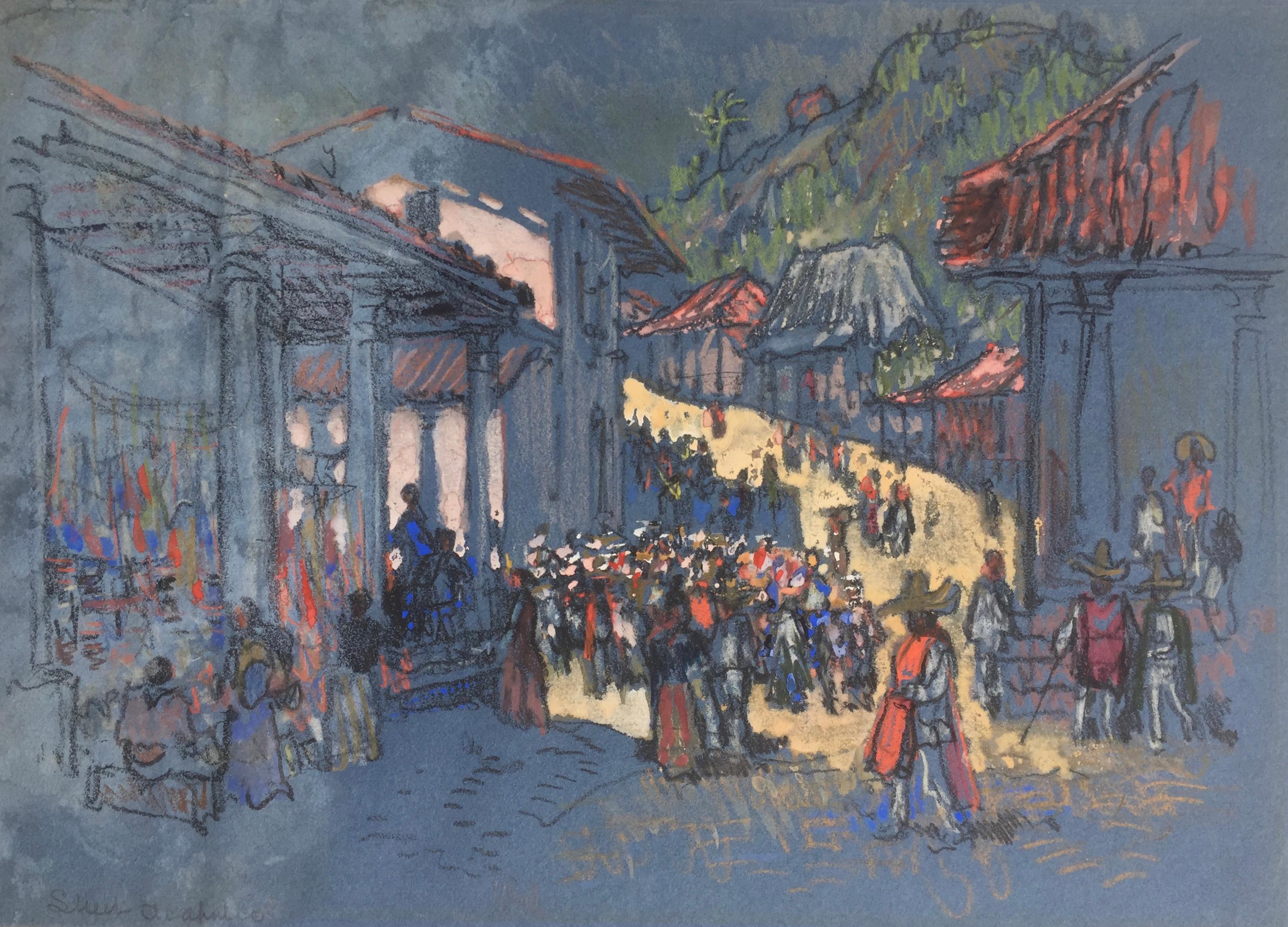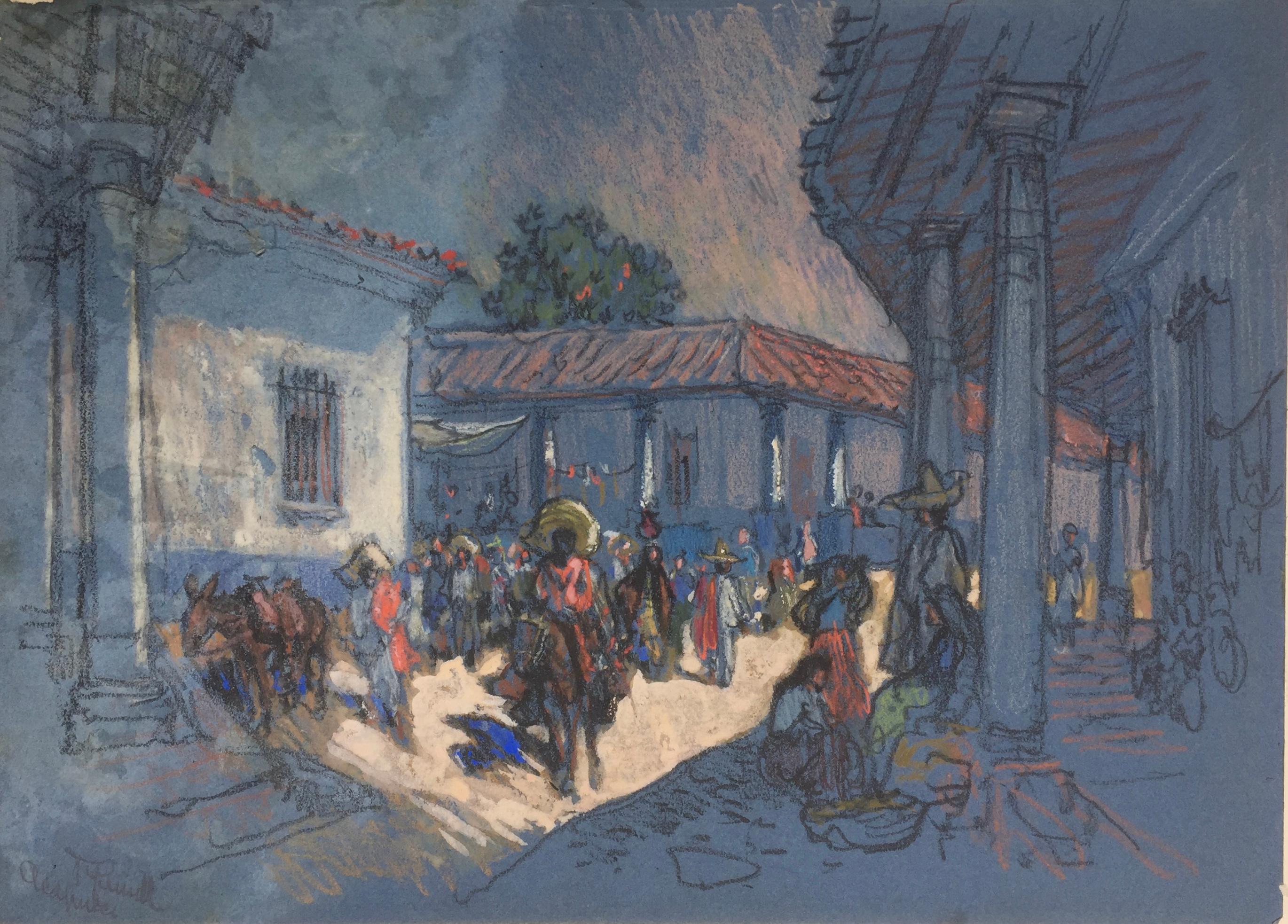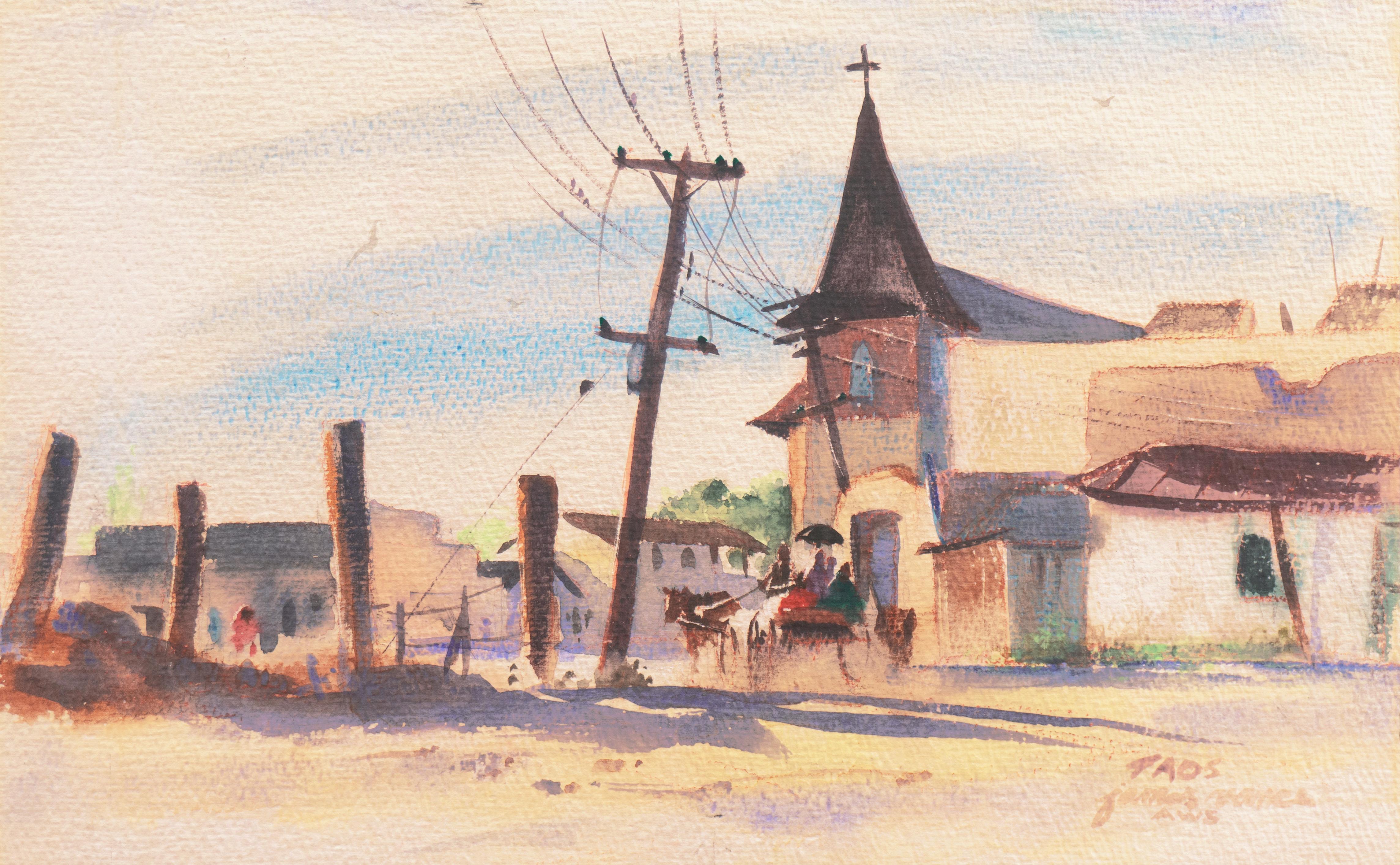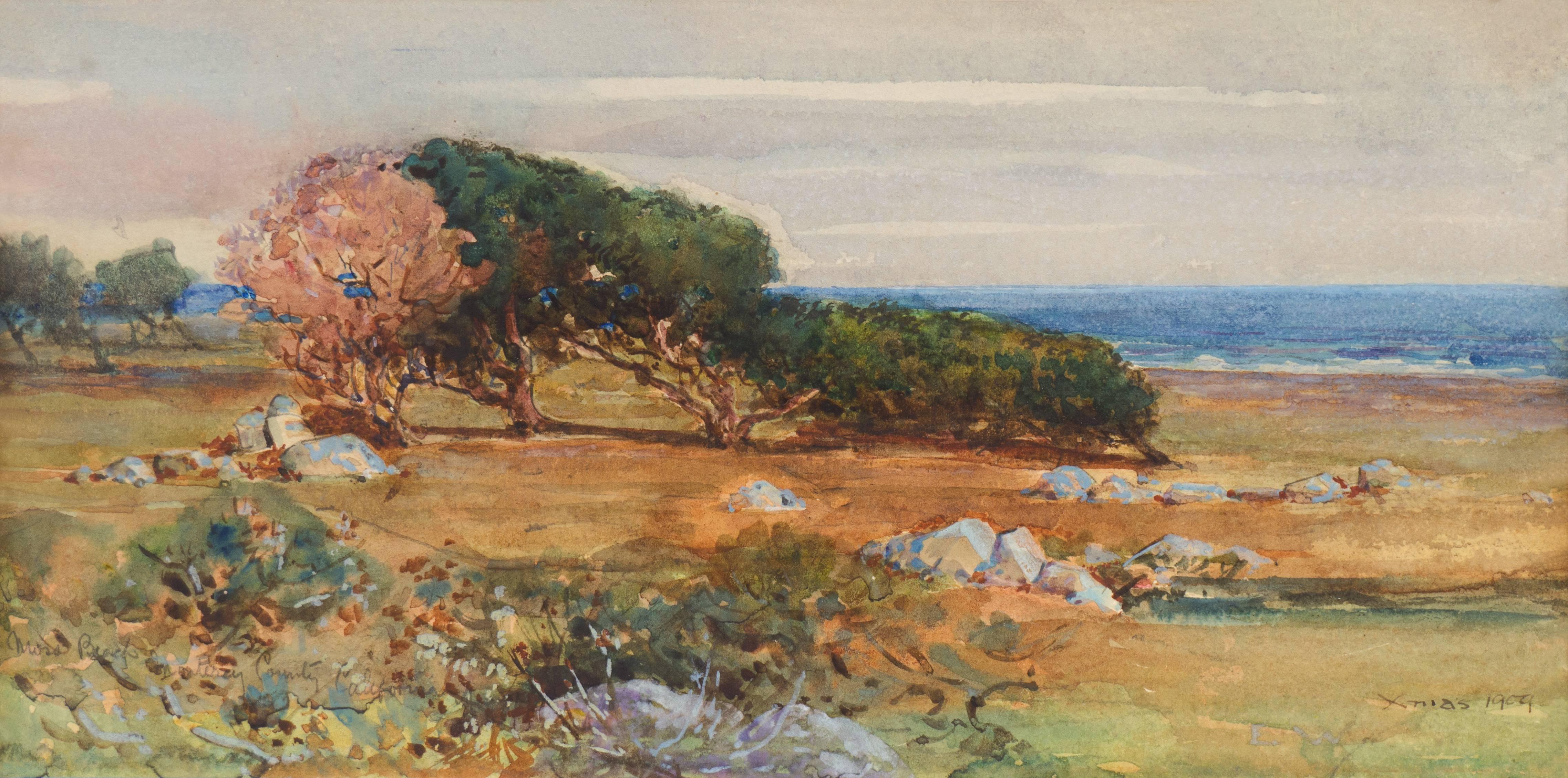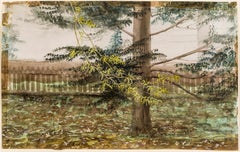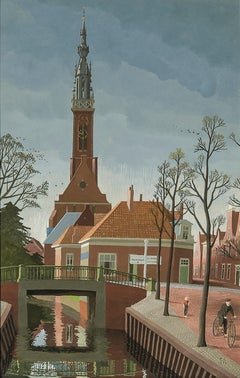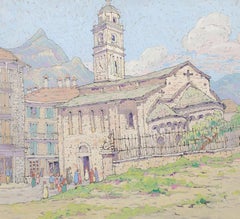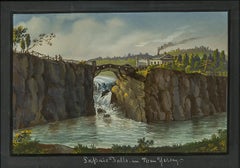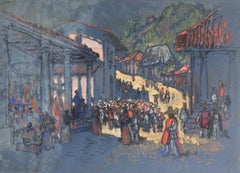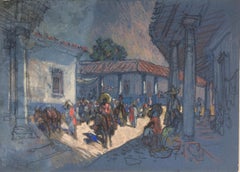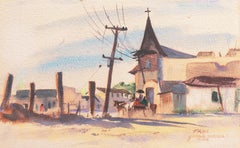Items Similar to Venice
Want more images or videos?
Request additional images or videos from the seller
1 of 8
Jane PetersonVenice 1919
1919
About the Item
Singed (at lower left): Jane Peterson
- Creator:Jane Peterson (1876-1965, American)
- Creation Year:1919
- Dimensions:Height: 17.5 in (44.45 cm)Width: 17.5 in (44.45 cm)Depth: 1.5 in (3.81 cm)
- Medium:
- Movement & Style:
- Period:
- Condition:
- Gallery Location:New York, NY
- Reference Number:Seller: APG 87371stDibs: LU236723172
Jane Peterson
Jane Peterson's most innovative period was from 1910 to 1930. During this time she produced her most important work. Her trips to Venice resulted in exuberant paintings full of glowing color. This painting is from that period. The brushwork is bold and exciting. The bright round yellow carob flowers contrast with the vertical mauve carob pods. The trunks and branches of the trees form a series of triangles that reflect the lush Mediterranean landscape. Originally the painting was sold in Paris to an American collector. Jane Peterson was a leading woman post-impressionist painter of the early 20th century. Born in Elgin, Illinois, on November 28, 1876, she was interested in art throughout her childhood. In 1895, she went to New York City to study art at Pratt Institute. Before graduating in 1901, Peterson taught painting and became a popular teacher at Pratt. She then became the Drawing Supervisor of Brooklyn Public Schools. She studied oil painting with Frank Vincent DuMond who emphasized a prismatic palette. Subsequently, she studied painting with Frank Brangwyn in London, Jacques Emile Blanche and André Lhote in Paris, and Joaquín Sorolla y Bastida in Madrid. She was influenced by Impressionism and Fauvism during her studies in Paris. In 1924, Peterson's painting, Toilette, received critical acclaim at the New York Society of Painters. Her one-woman show on Fifth Avenue sold out. By this time, she had won numerous awards, was a Fellow at the National Academy of Design, and a member of many art clubs including the American Watercolor Society, Audubon Artists, Pen & Brush Club, and the National Association of Women Artists. In 1925, The New York Times characterized Peterson as "one of the foremost women painters in New York." Known for her colorful, post-impressionistic paintings of Gloucester streets and harbor on Cape Ann; palm trees along the Florida coast; street scenes in Paris, Istanbul, and New York City; and boating views in Venice. Peterson also flamboyantly executed floral subjects and dynamic genre-like portraits. Carob Tree (Ceratonia siliqua) is a small evergreen tree of the Mediterranean coasts. It has dark green, compound leaves with glossy, oval leaflets. In Italy, the carob tree blooms from September to November. Its seedpods, also known as Saint John's bread, are up to 45 centimeters long and are filled with round, hard seeds and a thick pulp. St. John's Bread was probably the husks in the Prodigal Son parable and the seed which is said to have been the original jewelers' carat weight. The Spaniards call it Algaroba, and the Arabs Kharoub, hence Carob or Caroub Pods, Beans, or Sugar-pods. It is also named Locust Pods. These pods are grown in southern Europe for feeding domestic animals as well as for human food. Carob is sold in health food stores and is often a substitute or alternate to chocolate.
About the Seller
5.0
Recognized Seller
These prestigious sellers are industry leaders and represent the highest echelon for item quality and design.
Established in 1952
1stDibs seller since 2010
32 sales on 1stDibs
Typical response time: 17 hours
Associations
Art Dealers Association of America
- ShippingRetrieving quote...Ships From: New York, NY
- Return PolicyThis item cannot be returned.
Authenticity Guarantee
In the unlikely event there’s an issue with an item’s authenticity, contact us within 1 year for a full refund. DetailsMoney-Back Guarantee
If your item is not as described, is damaged in transit, or does not arrive, contact us within 7 days for a full refund. Details24-Hour Cancellation
You have a 24-hour grace period in which to reconsider your purchase, with no questions asked.Vetted Professional Sellers
Our world-class sellers must adhere to strict standards for service and quality, maintaining the integrity of our listings.Price-Match Guarantee
If you find that a seller listed the same item for a lower price elsewhere, we’ll match it.Trusted Global Delivery
Our best-in-class carrier network provides specialized shipping options worldwide, including custom delivery.More From This Seller
View AllTree and Fence, East Hartford, Connecticut (New England Landscape)
By Charles De Wolf Brownell
Located in New York, NY
Watercolor and gouache on paper
Category
Mid-19th Century American Realist Landscape Drawings and Watercolors
Materials
Gouache, Watercolor
Edam, Holland
By Thomas Fransioli
Located in New York, NY
Thomas Fransioli’s cityscapes are crisp and tidy. Buildings stand in bold outline, their forms squarely defined by stark light and long shadows. Saturated color permeates every corner of his canvases, from vibrant oranges and greens to smoky terra cottas and granites. Even the trees that line Fransioli’s streets, parks, and squares are sharp and angular, exactly like those in an architect’s elevation rendering. But Fransioli’s cities often lack one critical feature: people. His streets are largely deserted, save for parked cars and an occasional black cat scurrying across the pavement. People make rare appearances in Fransioli’s compositions, and never does the entropy of a crowd overwhelm their prevailing sense of order and precision. People are implied in a Fransioli painting, but their physical presence would detract from the scene’s bleak and surreal beauty.
Magic Realism neatly characterizes Fransioli’s artistic viewpoint. The term was first broadly applied to contemporary American art in the 1943 Museum of Modern Art exhibition, American Realists and Magic Realists. As exhibition curator Dorothy Miller noted in her foreword to the catalogue, Magic Realism was a “widespread but not yet generally recognized trend in contemporary American art…. It is limited, in the main, to pictures of sharp focus and precise representation, whether the subject has been observed in the outer world—realism, or contrived by the imagination—magic realism.” In his introductory essay, Lincoln Kirstein took the concept a step further: “Magic realists try to convince us that extraordinary things are possible simply by painting them as if they existed.”
This is Fransioli, in a nutshell. His cityscapes exist in time and space, but certainly not in the manner in which he portrays them.
Fransioli—and other Magic Realists of his time—was also the heir to Precisionism, spawned from Cubism and Futurism after the Great War and popularized in the 1920s and early 1930s. While Fransioli may not have aspired to celebrate the Machine Age, heavy industry, and skyscrapers in the same manner as Charles Sheeler, his compositions tap into the same rigid gridwork of the urban landscape that was first codified by the Precisionists.
During the 1950s, Fransioli was represented by the progressive Margaret Brown...
Category
20th Century American Realist Landscape Drawings and Watercolors
Materials
Gouache, Paper
San Gio, Como
By Eleanor Parke Custis
Located in New York, NY
Eleanor Park Custis painted scenes as varied as the artist's travels: from her hometown of Washington, D.C., to the coastal towns of New England; from the prosperous fishing villages of Brittany, to Venice and the mountain villages and lakes of northern Italy.
While Custis's subjects are diverse, her style is consistent and distinctive throughout this body of work. Her use of flat areas of color delineated by dark contours is reminiscent of the aesthetics of woodblock printing. Like many artists of the day, she was profoundly influenced by Japanese woodblock prints, and her adaptation of the aesthetic by 1924 led to her most productive artistic period.
Eleanor Custis hailed from a socially prominent Washington, D.C., family. She was distantly related to Martha Custis Washington, America's first First Lady. Custis began three years of formal art training in the autumn of 1915 at the Corcoran School of Art in Washington, and was guided and inspired by Impressionist artist Edmund C. Tarbell, one of the Ten American Painters, who became the Corcoran School's principal in 1918. Custis exhibited widely in many of the Washington art societies and clubs for much of her career. She was also a frequent exhibitor at the Grand Central Art Galleries in New York City; her last one-woman show there was in April 1945.
Custis's mature style emerged in scenes of the streets, wharves, and drydocks of seacoast villages from Maine to Massachusetts, which she visited during the summers of 1924 and 1925. She was working in Gloucester, Massachusetts in August 1924, and painted several gouaches of the town's wharves and winding streets, including In Gloucester Harbor and At the Drydock, Gloucester. During her stay, Custis may have met Jane Peterson or at least must have seen her work, the best of which was executed in Gloucester during the preceding ten years. The similarity between their styles is unmistakable, but, while it may be tempting to suggest that Custis was influenced by Peterson during her summer in Gloucester, the connection between their work is probably more a case of shared aesthetics and common European influences.
Custis expanded her subject repertoire with three trips to Europe between 1926 and 1929, and was inspired by the Old World charm of Holland, northern France, Switzerland, and Italy, leading to such works as New Kirk, Delft, Holland, Market Day in Quimper, At the Foot of the Matterhorn, and The Town Square, Varenna. A Mediterranean cruise in 1934 introduced her to the Near East, and the bustling, colorful streets and bazaars of Cairo, captured in works like A Street in Cairo, Egypt and A Moroccan Jug...
Category
20th Century American Realist Landscape Drawings and Watercolors
Materials
Gouache, Paper
Passaic Falls in New Jersey
By Nicolino V. Calyo
Located in New York, NY
Nicolino Calyo's career reflects a restless spirit of enterprise and adventure. Descended in the line of the Viscontes di Calyo of Calabria, the artist was the son of a Neapolitan army officer. (For a brief biographical sketch of the artist see Philadelphia Museum of Art, Pennsylvania, Philadelphia: Three Centuries of American Art, exhib. cat. [1976], pp. 299-301 no. 257.) Calyo received formal training in art at the Naples Academy. His career took shape amidst the backdrop of the political turbulence of early nineteenth-century Italy, Spain, and France. He fled Naples after choosing the losing side in struggles of 1820-21, and, by 1829, was part of a community of Italian exiles in Malta. This was the keynote of a peripatetic life that saw the artist travel through Europe, to America, to Europe again, and back to America.
Paradoxically, Calyo’s stock-in-trade was close observation of people and places, meticulously rendered in the precise topographical tradition of his fellow countrymen, the eighteenth-century
vedute painters Antonio Canale (called Canaletto) and Francesco Guardi. In search of artistic opportunity and in pursuit of a living, Calyo left Malta, and, by 1834, was in Baltimore, Maryland. He advertised his skills in the April 16, 1835 edition of the Baltimore American, offering "remarkable views executed from drawings taken on the spot by himself, . . . in which no pains or any resource of his art has been neglected, to render them accurate in every particular" (as quoted in The Art Gallery and The Gallery of the School of Architecture, University of Maryland, College Park, 350 Years of Art & Architecture in Maryland, exhib. cat. [1984], p. 35). Favoring gouache on paper as his medium, Calyo rendered faithful visual images of familiar locales executed with a degree of skill and polish that was second nature for European academically-trained artists. Indeed, it was the search for this graceful fluency that made American artists eager to travel to Europe and that led American patrons to seek out the works of ambitious newcomers.
On June 16, 1835, the Baltimore Republican reported that Calyo was on his way north to Philadelphia and New York to paint views of those cities. Calyo arrived in New York, by way of Philadelphia, just in time for the great fire of December 1835, which destroyed much of the downtown business district. He sketched the fire as it burned, producing a series of gouaches that combined his sophisticated European painting style with the truth and urgency of on-the-spot observation. Two of his images were given broad currency when William James Bennett reproduced them in aquatint. The New-York Historical Society owns two large Calyo gouaches of the fire, and two others, formerly in the Middendorf Collection, are now in the collection of Hirschl & Adler Galleries. From 1838 until 1855, Calyo listed himself variously in the New York City directories as a painter, a portrait painter, and as an art instructor, singly, and in partnership with his sons, John (1818-1893) and later, the younger Hannibal (1835-1883). Calyo also attracted notice for a series of scenes and characters from the streets of New York, called Cries of New York. These works, which were later published as prints, participate in a time-honored European genre tradition. Calyo’s New York home became a gathering place for European exiles, including Napoleon III. Between 1847 and 1852 Calyo exhibited scenes from the Mexican War and traveled from Boston to New Orleans with his forty-foot panorama of the Connecticut River. Later, he spent time in Spain as court painter to Queen Maria Christina, the result of his continuing European connections, but he was back in America by 1874, where he remained until his death.
The Passaic River rises in the hills just south of Morristown, New Jersey, marking a serpentine eighty-mile course before it empties into Newark Bay. It flows north-northeast to Paterson, where it falls seventy feet in a spectacular cataract before continuing south through Passaic and Newark. William Gerdts, in Painting and Sculpture in New Jersey (1964, pp. 51-2), describes the falls as:
the most important [landscape] subject in New Jersey during the eighteenth and nineteenth centuries. . . . The Passaic Falls remained a popular spot, particularly during the romantic period. Indeed, newspapers, periodicals, and gift books contain many accounts of visits to the Falls, sentimental poems written about them or about a loved one visiting the Falls, or even, occasionally, in memory of one who perished in the waters of the Falls — usually intentionally. . . . Waterfalls . . . were popular among travelers in the period and the Passaic Falls were only surpassed by Niagara Falls and Trenton Falls...
Category
19th Century American Realist Landscape Drawings and Watercolors
Materials
Gouache, Paper
Untitled (The Road to Swindon)
By Colin Hunt
Located in New York, NY
Colin Hunt (b. 1973) is a Brooklyn, NY-based artist working primarily in egg tempera and watercolor. His recent series of landscapes of the Avebury stone circle outside of London are...
Category
21st Century and Contemporary Photorealist Landscape Drawings and Waterc...
Materials
Watercolor
Belvedere Castle
By Frederick Brosen
Located in New York, NY
Signed (lower right): Brosen 21
A native New Yorker, Brosen has spent a lifetime wandering its streets, discovering its long history and witnessing its constant metamorphosis. The c...
Category
2010s Contemporary Landscape Drawings and Watercolors
Materials
Watercolor, Paper, Graphite
You May Also Like
STREET ACAPULCO
By Joseph Pennell
Located in Santa Monica, CA
JOSEPH PENNELL (1857 - 1926)
STREET ACAPULCO 1901-08. Color pastel and gouache drawing on blue paper. Signed and titled in pencil in his early signature. Image, 10 x 14 inches to j...
Category
Early 1900s American Impressionist Landscape Drawings and Watercolors
Materials
Pastel, Mixed Media, Gouache
$1,240 Sale Price
24% Off
ACAPULCO
By Joseph Pennell
Located in Santa Monica, CA
JOSEPH PENNELL (1857 - 1926)
ACAPULCO 1901-08.
Colored pastel and gouache drawing on blue paper. Signed and titled in pencil in his early signature. Image 10 x 14 inches to just ab...
Category
Early 1900s American Impressionist Landscape Drawings and Watercolors
Materials
Pastel, Gouache
$1,320 Sale Price
20% Off
'Taos', American Watercolor Society, Chouinard, New York, Art Student's League
Located in Santa Cruz, CA
Signed lower right, 'James Vance, AWS', (American, 1919-2007), titled 'Taos' and painted circa 1950.
James Vance grew up in Los Angeles and first applied ...
Category
1950s American Impressionist Landscape Drawings and Watercolors
Materials
Paper, Watercolor, Gouache
'Moss Beach, Monterey, California', Pacific Coastal Landscape, ASL NYC, Benezit
By Elmer Wachtel
Located in Santa Cruz, CA
An early-20th-century, landscape showing a view of the coastline at Moss Beach in Monterey County with slate-blue skies overhead and a view towards a stand ...
Category
Early 1900s American Impressionist Landscape Drawings and Watercolors
Materials
Paper, Watercolor, Gouache
Canal at Indian Mound Road
By Ben Fenske
Located in Sag Harbor, NY
Painted during the 2015 Winter Equestrian Festival in Wellington, Florida. A black and white depiction of a canal, is barely recognizable, due to Fenske's wild brushstrokes and lack...
Category
21st Century and Contemporary American Impressionist Landscape Paintings
Materials
Gouache, Paper
"House on a Hill, " Clara Bell, Female Artist Landscape, American Impressionism
Located in New York, NY
Clara Louise Bell (1886 - 1978)
House on a Hill, circa 1935
Gouache on artist board
7 1/4 x 9 7/8 inches
Clara Louise Bell (Mrs.Bela Janowsky) was b...
Category
1930s American Impressionist Landscape Paintings
Materials
Gouache, Board
Recently Viewed
View AllRead More
With Works Like ‘Yours Truly,’ Arthur Dove Pioneered Abstract Art in America
New York gallery Hirschl & Adler is exhibiting the bold composition by Dove — who’s hailed as the first American abstract painter — at this year’s Winter Show.
Remarkably, Elizabeth Turk’s Sculptures Highlight the Lost Voices of Extinct Birds
In one of the first live and in-person exhibitions at a Manhattan gallery since last spring, the California-based sculptor gives the lost voices of endangered and extinct birds and animals a magnificent embodied form.
More Ways To Browse
Framed Venice
Venice Framed Art
Venice Antique
Antique Venice Painting
Venice Antique Paintings
Impressionist Venice
Paintings Early 20th Century Venice
Antique Singer
Gouache Venice
Peterson Antique
Terry Walsh
The Sower Pissarro
Turner Messick
Tzvi Raphaeli
Verne R Horton
Vernon Nye
Vincent Nesbert
Vintage Adirondack Map
